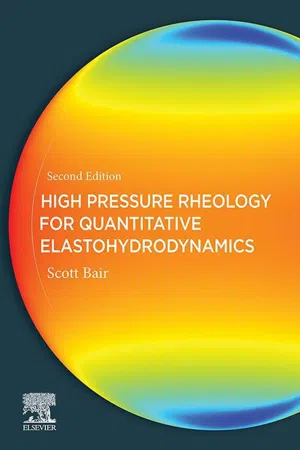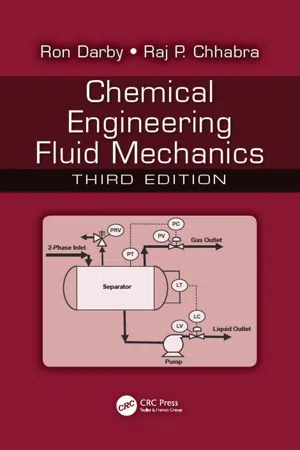Physics
Compressibility
Compressibility is a measure of how much a substance's volume decreases under pressure. It is the reciprocal of the substance's bulk modulus, which is a measure of its resistance to compression. Compressibility is an important property in the study of fluids and gases.
Written by Perlego with AI-assistance
Related key terms
Related key terms
1 of 4
Related key terms
1 of 3
6 Key excerpts on "Compressibility"
- eBook - ePub
From Deep Sea to Laboratory 3
From Tait's Work on the Compressibility of Seawater to Equations-of-State for Liquids
- Frederic Aitken, Jean-Numa Foulc(Authors)
- 2019(Publication Date)
- Wiley-ISTE(Publisher)
1.2. Concepts of CompressibilityCompressibility is a general property of a material that causes anything to reduce its volume under the effect of pressure. This property is characterized by coefficients that can be different depending on the material concerned (gas, liquid or solid). In the case of a liquid (usually a state of matter that cannot withstand static shear stress without flow), the only modulus that can be defined is its modulus of elasticity in volume κ, also called the tangent modulus in volume.A specific volume V of liquid that is subjected to a hydrostatic pressure variation ΔP = P – P0 (P is the applied pressure and P0 the reference pressure) undergoes a volume decrease equal to ΔV; its deformation in volume is: -ΔV/V. The modulus of elasticity in volume is then, by definition:[1.3]The reference pressure P0 is often taken as 1 atmosphere. In practice, since the pressures applied to measure the Compressibility of liquids are much higher than 1 atm, the pressure variation is considered to be equal to the pressure applied (i.e. ΔP = P).The value of the module κ depends on the speed at which pressure variations occur. If the pressure is applied slowly, the liquid will remain at a constant temperature and, under these conditions, we will have an isothermal module κT . If the pressure variations are so rapid that there can be practically no heat exchange between the liquid and its environment, then we will have an adiabatic module κS - Christina G. Georgantopoulou, George A. Georgantopoulos(Authors)
- 2018(Publication Date)
- Wiley-ISTE(Publisher)
dynamic pressure which is originated by the forces exerted by the fluid during its motion can be calculated as:[1.22]where pa is the dynamic pressure, ρ is the density of the fluid and V is the velocity.The sum of static and dynamic pressure is the total pressure.1.3.5. CompressibilityCompressibility is a characteristic property of fluids as the meter of the volume variation under the influence of external forces. The volume variation is a function of the fluids’ elasticity, which is expressed in a similar way by Hook’s law in solids. Consequently, a linear function pressure–volume variation is applied as:[1.23]where E is the meter of elasticity (bulk modulus) and ∆v/v0 is the volume variation due to the pressure variation ∆p. The minus (−) sign means that the volume variation is negative.As given by equation [1.23] , the meter of elasticity is reversed to the Compressibility (high meter of elasticity means low Compressibility), and hence the Compressibility is expressed by 1/E. In addition, as the ratio ∆v/v0 dimensionless, the meter of elasticity units are pressure units.The Compressibility of liquids is very low. For example, the bulk modulus of water is equal to 20,000 kP/cm2 , which means that if we increase the pressure of the water volume v0 for 1 kP/cm2 , the volume variation will be approximately 1/20,000–0.00005. Most liquids show similar behaviors, and hence they are assumed to be incompressible.In the case of gases, the bulk modulus E is equal to the initial pressure p0 of a certain gas quantity v0 when the process is isothermal (the isothermal process is called a gas process where the pressure and the volume are varied but the temperature remains constant). Consequently, we have to prove that in gases, if T = const, then E = p0- eBook - ePub
200 Science Investigations for Young Students
Practical Activities for Science 5 - 11
- Martin Wenham(Author)
- 2000(Publication Date)
- SAGE Publications Ltd(Publisher)
Table 7.1 .7.2: Compressibility
If an object or material can be squashed into a smaller volume when forces are applied to it, it is said to be compressible. The scientific view is that gases are compressible, whereas liquids and solids are not, but children may be puzzled by solids which appear to be compressible.Table 7.1 Summary of mechanical properties of materials and objectsThe Compressibility of air and water can be investigated in a number of ways. One of the simplest and most convincing is to use fairly large disposable plastic syringes, but in a social context where these may be associated with drug abuse, experimenting with them may be unacceptable. Substitutes, which can be used in much the same way, are bicycle pumps and plastic drink bottles.Activity 7.2.1
Investigating Compressibility
Equipment: Bicycle pump (the simplest form is the most useful); large plastic drink bottle with gas-tight screw-top; balloon; bucket; water.- Take a bicycle pump to pieces to see how the piston moves in the barrel, then put it back together again.
- Pull the pump-handle out, put the forefinger of the other hand over the hole on the other end of the pump so no air can escape, and push the handle in again.
- What happens? (It gets harder and harder to push the handle in until it cannot be pushed in any more.)
- When you cannot push the pump-handle in any more, what do you know about the forces acting on the handle? (They must be balanced. There must be a force pushing out equal to the force you are exerting by pushing in.)
- What could be exerting this outward push force? (The air in the pump pushing on the piston and the handle.)
- eBook - ePub
- Richard E. Meyer(Author)
- 2012(Publication Date)
- Dover Publications(Publisher)
CHAPTER 6Some Effects of Compressibility
33. Thermodynamic State
The restriction to incompressible fluid motion has been of help in the preceding chapters by excluding mathematical complications not germane to the issues, but it has necessarily led to a warped picture of fluid dynamics. An introduction to compressible fluid motion in the spirit of the earlier chapters would require a second book of similar length. It is worthwhile, however, to correct the balance partially by a sketch of two salient concepts of gas dynamics, namely, that of a shock and that of flow initiation by plane waves.Postulates I to IX of Chapters 1 to 3 are clearly inadequate to this purpose, because they do not suffice to define the relation between the density and the other fluid-dynamical quantities. To remedy this requires the addition of the axioms of thermodynamics. But in view of the limited aim of this chapter, a more informal approach will be adopted, and thermodynamical notions will be introduced only to the minimum extent needed for the immediate discussion. Body forces and radiation will be ignored (except in Section 38), since they play no essential role in the processes considered.Thermodynamics is concerned with substances many physical properties of which can be described in terms of a relatively small number of properties called variables of state . Examples of such variables are the pressure p , absolute temperature T , density p , and entropy S per unit mass. The primary concern of thermodynamics is therefore with relations between such variables, rather than with questions concerning their experimental definitions, and that point of view will also suffice for this chapter. It will be sufficient, moreover, to consider pure substances , defined as those for which the values of all variables of state are determined when the values of two among them are known. That implies, for any given pure substance, the existence of functional relations between any set of three variables of state, such as S = S (p, p ) or p = ρ (p, T ), which are called equations of state - Scott S. Bair(Author)
- 2019(Publication Date)
- Elsevier(Publisher)
Chapter FourCompressibility and the Equation of State
Abstract
For most engineering applications, liquids are treated as incompressible. Elastohydrodynamics is not a typical engineering application as the pressures are sufficiently large to result in significant increases in density of the liquids. In fact, the pressure dependences of the thermophysical properties of these liquids can often best be correlated with the temperature and density. The simple dilatometer, in which a piston is driven into a cylinder containing liquid, is sufficient for detecting phase changes; however, this approach cannot accurately produce the equation of state which the most precise viscosity correlations require. Relative volume data are provided for some lubricants and well-defined pure liquids and an equation of state is offered for simulations to replace the less accurate universal form in use today.Keywords
Pressure–volume–temperature; refractive index; Compressibility; bulk modulus; dilatometer; thermal expansivity; bellows piezometer; refractometer; longitudinal sound velocity; equation of state4.1 Background
For most engineering applications, liquids are treated as incompressible. In acoustics and low-pressure hydraulics, where the Compressibility is certainly important, the compression,, may be regarded as linear with pressure and very small relative to the ambient pressure volume,V 0− VV 0. Elastohydrodynamic lubrication (EHL) is quite different from these examples in the magnitude of pressure and the relative compression involved. A liquid lubricant pressurized to 1 GPa at 0°C may experience a relative compression,(, of 20% and at 200°C of 30%. The compression is very nonlinear for EHL pressures. The first half of the compression at 1 GPa comes at a pressure of 1/3 GPa at 0°C and at only 1/4 GPa at 200°C. Here and throughout this book, the distinction betweenV 0− V ) /V 0p = 0 and p = 1 atmosphere- eBook - ePub
- Ron Darby, Raj P. Chhabra(Authors)
- 2016(Publication Date)
- CRC Press(Publisher)
9 Compressible Flows“Surely it is not knowledge, but learning; not owning but earning; not being there, but getting there; that gives us the greatest pleasure.”—Carl Friedrich Gauss, 1777–1855, Mathematician and PhysicistI. GAS PROPERTIESThe main difference between the flow behavior of incompressible and compressible fluids, and the equations that govern them, is the effect of variable density, for example, the dependence of density upon pressure and temperature. At low velocities (relative to the speed of sound), relative changes in pressure and associated effects on density are often small and the assumption of incompressible flow with a constant (average) density may be reasonable. It is when the gas velocity approaches the speed at which a pressure wave propagates (i.e., the speed of sound) that the effects of Compressibility become the most significant. It is this condition of high-speed gas flow (“fast gas”) that is of greatest concern to us here.A. IDEAL GASAll gases are “nonideal” in that there are conditions under which the density of the gas may not be accurately represented by the ideal gas law:ρ =P MR T(9.1) However, there are also conditions under which this law provides a very good representation of the density for virtually any gas. In general, the higher the temperature and the lower the pressure relative to the critical temperature and pressure of the gas, the better the ideal gas law represents gas properties. For example, the critical conditions for CO2 are 304 K, 72.9 atm, whereas for N2 they are 126 K, 33.5 atm. Thus, at normal atmospheric conditions (300 K, 1 atm), N2 can be described very accurately by the ideal gas law, whereas CO2 deviates significantly from this law under such conditions. This is readily discernible from the P–H diagrams for the substance (see, e.g., Appendix D ), because ideal gas behavior can be identified with the conditions under which the enthalpy is independent of pressure, that is, the constant temperature lines on the P–H diagram are vertical (see Section III.B of Chapter 5
Index pages curate the most relevant extracts from our library of academic textbooks. They’ve been created using an in-house natural language model (NLM), each adding context and meaning to key research topics.
Explore more topic indexes
Explore more topic indexes
1 of 6
Explore more topic indexes
1 of 4





